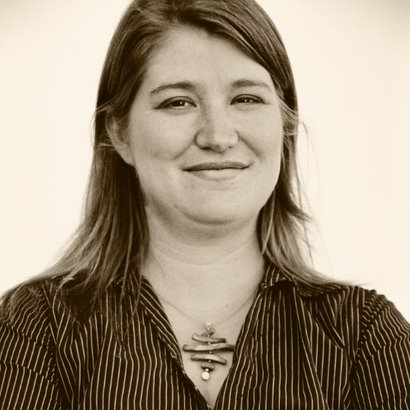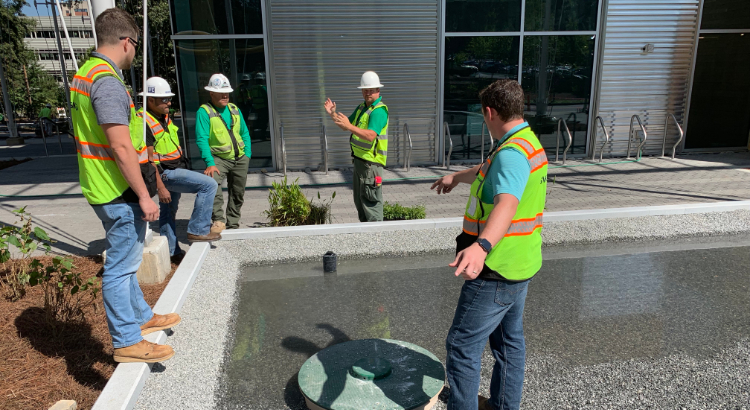Upon completion of the Kendeda Building, we asked seven team members to reflect on their work on a complex Living Building Challenge project. As a lens, they used the LBC’s seven Petals. Check out all the Petal Columns by clicking here.
Have you ever been in a relationship — with, say, a spouse, a coworker or a friend — where things became so comfortable that you started taking the person for granted? Where you stopped investing in the ties between you and forgot what you had valued in the first place?
That is what happened between people and water.
Water is an essential ingredient for our very existence. It played a major role in where we settled, what we ate and how we got places. It still does, of course. But today most of us simply turn on the faucet without a thought about where our water comes from, or where it goes once we’ve used it.
The Kendeda Building for Innovative Sustainable Design presented my colleagues and me with the opportunity to design a building that could begin to restore and revive our vital connections to that old friend – and to re-engage in a loving, caring relationship with the natural systems that sustain us and our place.

When it comes to water, the particulars of that place are important. In the case of the Kendeda Building, “place” doesn’t just refer to the Georgia Tech campus, but to the broader community of life in the region. For much of the Atlanta region that invaluable gift is defined by the Chattahoochee River watershed.
Our approach to handling water in and around the Kendeda Building was informed by an assessment of the watershed’s supply limitations and its stormwater pollution challenges, as well as by the guidance of the LBC Water Petal.
According to the International Living Future Institute, the LBC’s certifying body, the Water Petal is intended to “realign how people value water; to address the energy and chemicals involved in transporting, purifying, and pumping water; and to redefine ‘wastewater’ as a precious nutrient and resource.” The Petal calls for buildings to minimize waste, pollution and downstream impacts, and to work with rainwater and the natural flows on the site and its surroundings to supply its own water needs, recycle water and treat wastewater.
We began by asking: How can this place be an active steward of its watershed? How can it handle the water it uses in ways that improve rather than degrade the broader community of life here and downstream? We knew that we needed to elevate water as the precious resource it is. Water would not be taken for granted. It would be celebrated.
And there’s a lot to celebrate.
The Kendeda Building demonstrates resilient solutions for supplying and cleaning water in a water-stressed region. Even in drought, it will have enough water for its users and landscape. Because the building harvests all the water it needs, cleans all it uses and returns treated water to the aquifer, even simple everyday acts have a positive impact.
The building’s water infrastructure isn’t hidden either. It is fully exposed, to remind visitors where the water comes from and where it goes. Here are a few of the project’s many cutting-edge features:
The Piedmont Forest Approach: By intercepting and infiltrating rainwater close to where it falls, and minimizing the runoff, the building’s stormwater approach focuses on mimicking the Piedmont forest that covered the site before European settlement. The sloping landscape presented an opportunity to create a series of cascading underground basins beneath the building’s large porch and under permeable pathways that capture, treat and infiltrate water.
Water from the Sky: Water that falls on the building’s solar array and rooftop is routed into a 55,000-gallon cistern in the basement. This precious supply will be treated and disinfected to meet 100 percent of the building’s potable water demand. The treatment system will be permitted for public water supply by the Georgia Environmental Protection Division and will be regularly monitored to ensure it is safe. The building is expected to capture more water than it needs so the overflow will infiltrate into the ground, which should qualify it to meet the “net positive” imperative of the Water Petal.
Saving Water and Cycling Nutrients: An early design decision was made to remove the heaviest water consumer in the buildings: conventional flush toilets. In their place, a bank of composters in the building’s basement accepts waste from foam flush toilets and waterless urinals. The foam flush toilets use only a few ounces of water per flush, and the composters transform human waste into perfectly safe material that will enrich soils in the surrounding landscape.
Wetland Filter and Aquifer Recharge: Water from sinks, showers and drains is treated and infiltrated on site. A constructed wetland, filled with native plants and dedicated to demonstrating the power of nature to create clean water, is situated at the building entrance. The wetland filters greywater before it is infiltrated back to the groundwater through a drainfield located on the lower part of the site.
Irrigating with condensate: Since irrigation is one of the biggest consumers of freshwater, especially in hot climates, supplying plants with an alternative water source further reduces the building’s water footprint. Condensate from the building’s cooling system is produced during the same season as irrigation demand, making these two a good match. Condensate is harvested in a storage tank in the basement and sent to the irrigation system while rainwater from the cistern is used as a backup source.
The cumulative impact of these engineering decisions is nothing short of remarkable. Step into the Kendeda Building and enter into a new relationship with an old friend. Enjoy the shade of a solar array that not only generates power but harvests rainwater. Drink fresh rainwater from a fountain and know that you aren’t drawing potable water from the stressed supply. Use the restroom, where potable water isn’t wasted on flushing, and composting toilets transform your waste into a resource for creating healthy soil. Grab a seat beside the constructed treatment wetland, where plants and beneficial bacteria are churning away to clean greywater from the building’s sinks and showers so that it can be returned to the aquifer. Gaze at the landscape and rain gardens that are hard at work slowing down stormwater and filtering out dirt and urban detritus so it won’t end up in the Chattahoochee.
Oh, and don’t forget to thank the students you see in this building. Some of them helped plan, design, and pilot test the innovative solutions demonstrated here.
Erin English brings 18 years of engineering expertise to her work in innovative water master planning, wastewater treatment, stormwater treatment, and water reuse projects. She leverages her educational background in chemical engineering for advancing ecological wastewater process design and innovation. As a senior engineer with Biohabitats, a firm focused on ecological restoration, conservation planning and regenerative design, she applies ecological justice, watershed-thinking and resilient water design to her daily engineering practice.
Photo at top: Skanska site managers coordinate with subcontractors to install plants for a constructed wetlands at the Kendeda Building. The wetlands help to treat greywater from the building. Photo by Ken Edelstein.


